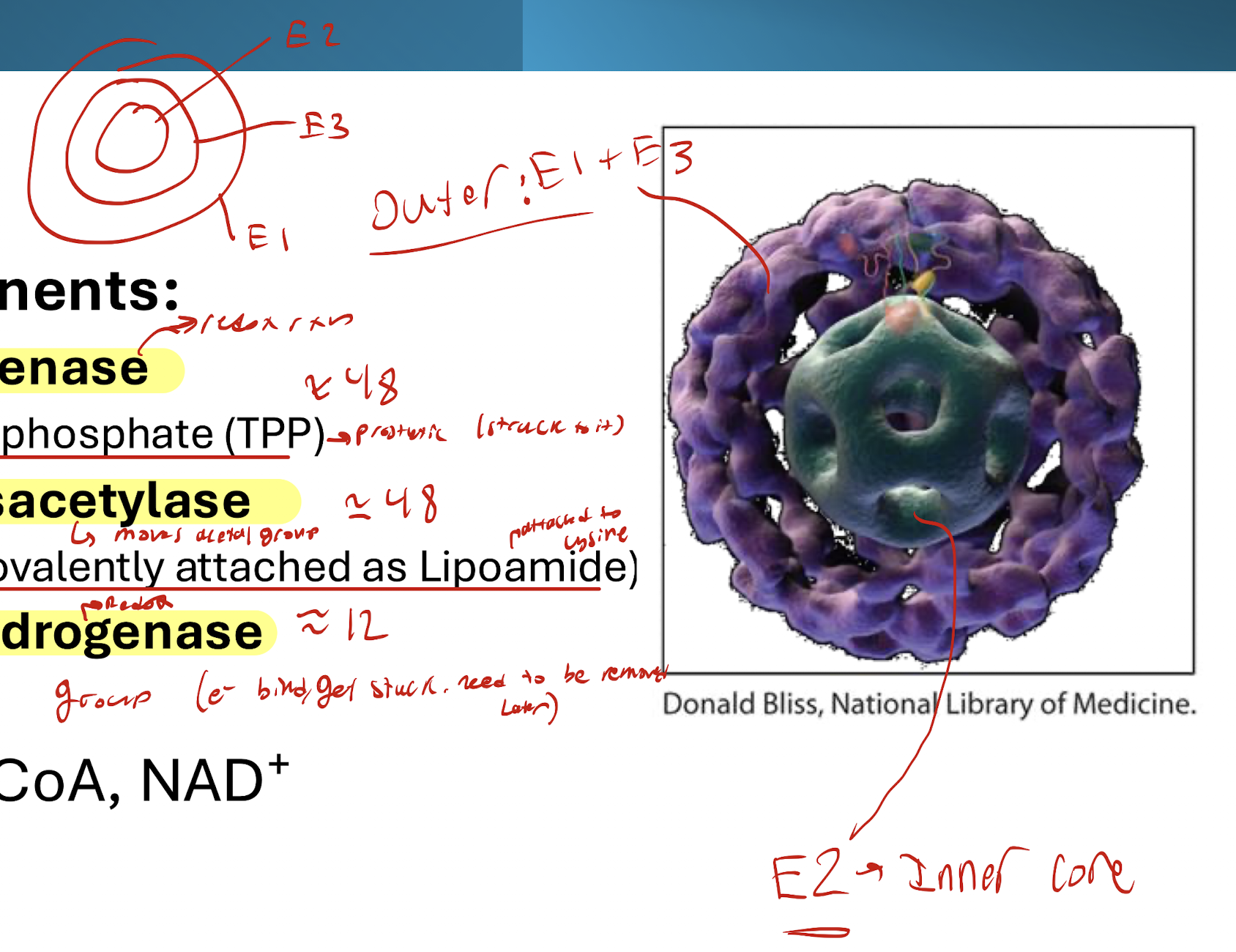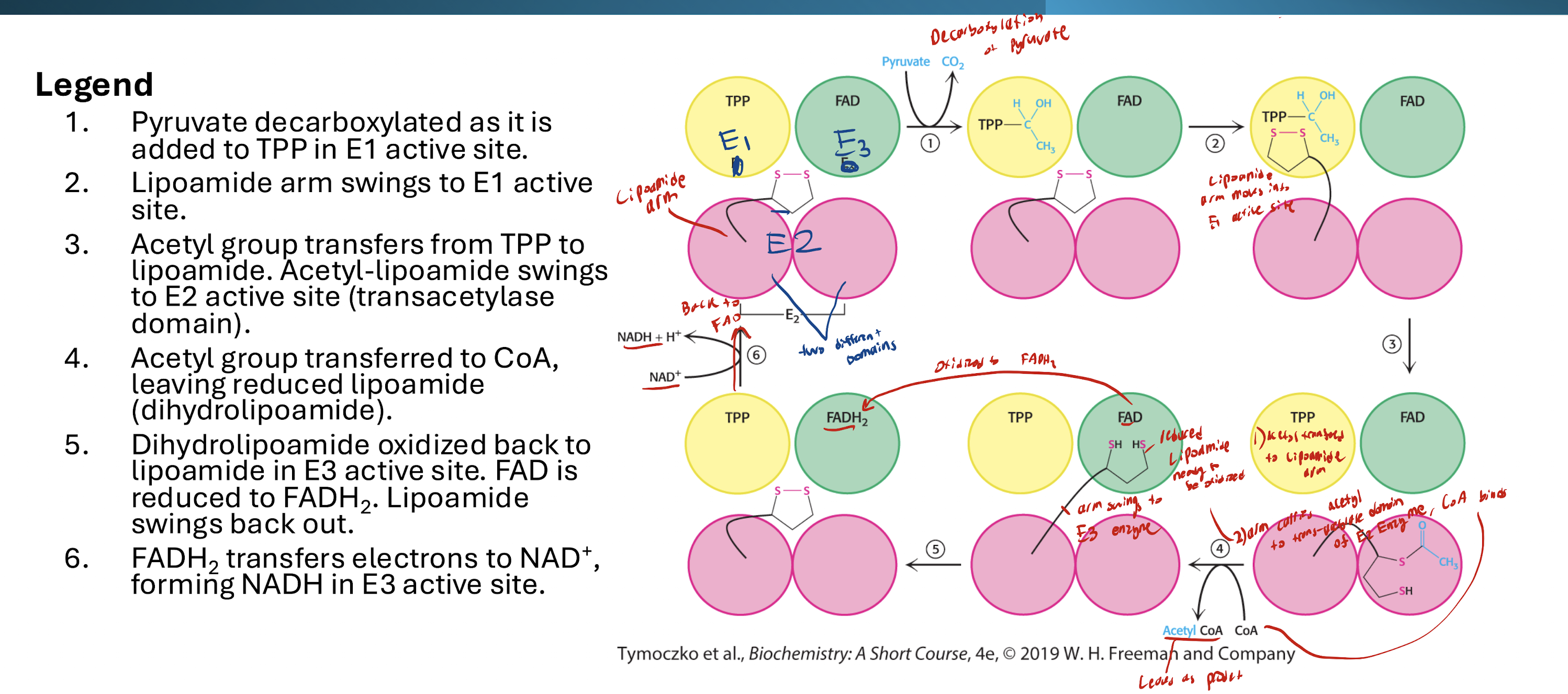Chapter 18 - Pyruvate Dehydrogenase Complex (PDC)
1/22
There's no tags or description
Looks like no tags are added yet.
Name | Mastery | Learn | Test | Matching | Spaced |
|---|
No study sessions yet.
23 Terms
What is the pyruvate dehydrogenase complex? WHere is it located
The metabolic bridge. A protein complex that links glycolysis (carb metabolism) to the TCA
In the Intermembrane of mitochondria (embedded in it)
Where does glycolysis occur? where’s it go for aerobic respiration
The Cytoplasm
Pyruvate goes into the mitochondria
What does the PDH do?
Converts pyruvate to acetyl-CoA (which then enters TCA)
what is the overall reaction that takes place in the PDH. Where does it happen,
image

What is the eneregetics of the pDH compelx reaction. What does that mean
-33.5kJ/mol (very favorable reaction)
thus irreversible in normal physiology conditions
What are the 3 parts of the complex? How many enzymes make up each? how many complexes in each cell? What does that mean?
E1 - 48
E2 - 48
E3 - 12
Total: 108 enzymes PER COMPLEX
TONs of complexes per cell
a ton of these enzymes are present
What is the structural arrangement of the complex?
Outermost: E1
Middle Outer: E3
Inner: E2
Outer is E1 and E3
Inner is E2

What are the enzymes and cofactors presenet with each component?
E1
Enzyme: Pyruvate Dehydrogenase
Cofactor: TPP (thiamine pyrophosphate, Vitamin B1), prosthetic cofactor
E2
Dihydrolipoyl transacetylase
Cofactor: Lipoic acid (bonded to Lipoamide via histidine residue), covalently bonded cofactor
E3
Dihydrolipoyl Dehydrogenase
Cofactor: FAD (from Riboflvain, vitamin B2), prosthetic cofactor
What are additional cofactors present in the complex
CoA (coenzyme A)
NAD+
What happens in the first step of the E1 reaction with pyruvate in the PDC complex?
Pyruvate decarboxylyzed (via TPP carbonanion), and attached to TPP with two less carbons (CO2 which left) —> Forms Hydroxyethyl-TPP

What happens in the second step of the E1 reaction?
How does the acetyl group transfer?
Hydroxyethyl -TPP reacts wth Lipoamide
Acetyl group from hydroxyethyl-TPP transfers to lipoamide
The top sulfure of lipoamide attacks OH, increasing affinity for the second sulfure of lipoamide on the bottom, which then attacks the central carbon and has the acetyl group added to the sulfure.
→ Forms Acetyl-Lipoamide

What happens in the E2 reaction?
Acetyl-lipoamide transfers acetyl group to Coenzyme A
→ Acetyl-CoA + Dihydrolipoamidez

What happens with the E3 reaction? What happens with the FADH2, why is it used?
Dihydrolipoamide is converted bac, to Lipoamide (Can’t react as dihydrolipoamide, needs to be converted into lipoamide)
Dihydrolipoamide + FAD → Lipoamide + FADH2 + NAD+ → FAD+ + NADH
FADH2 needs to be converted back to FAD (NAD+ takes the electrons, making NADH), producing FAD

Summarize the steps and draw out th emovement of the lipamide arm of E2 of what happens with the PDH coplex enzyme
—

What are the types of modifications done by the PDH complex?
Covalent Modification (primary control)
Allosteric Regulaiton (fine-tuning)
How does PDC complex get activated and inactivated? What enzymes are involved with each
Phosphorylation → Inativation
PDH Kinase
Dephosphorylation → Activation
PDH Phosphatase
How do pdh kinase and pdh phosphatase work? What specificly activates each
INC energy charge (ATP, acetyl-CoA, NADH) —Activates→ PDH Kinase → Phosphorylates E1 → Complex turns off
DEC energy charge (Ca2+, ADP) —Activates→ PDH phopsphatase → Dephosphorylates E1 → Complex turns on
How is PDC allosterically regulated?
Fine-tune regulation
Products of reaction inhibit the formation
Acetyl-CoA inhibits E2
NADH inhibits E3
(high energy charge → Inhibiting PDC)
How does PDH Compelx respond to cellular needs (fed and fasted states)? TALK ABOUT FED STATE IN THIS
Fed State (Insulin signaling)
PDH phosphatase activated (PDC gets dephosphorylated, activated)
makes sense b/c body just ate and glucose is being broken down into energy
Glucose present, it is used. Acetyl-CoA also used for fatty acid synthesis

How does PDH Compelx respond to cellular needs (fed and fasted states)? TALK ABOUT FASTED STATE IN THIS
Fasted/Stress state
PDH Kinase activated (PDC gets phosphorylated, INactivated)
makes sense b/c no glucose, nothing to make
Tissues preserve glucose, oxidize fatty acids instead)

What are types of defects that contribute to PDH complex deficiency>
Genetic Defects
Lactic acidosis
Neurological problems
Developmental delays and growth impairment
What happens with each of these: Genetic Defects as a result of PDH complex defficiency)
Lactic acidosis
Neurological problems
Developmental delays and growth impairment
Lactic acidosis
Pyruvate → Lactate instead of acetyl-CoA (buildup of lactic acid bc fermentation occurring because no PDH complex to bring pyruvate into the mitochondria)
Neurological problems
Brain not getting energy from glucose metablosim (dependent on it)
Developmental delays and growth impairment
because not enough energy is being produced if PDH complex can’t be formed to bring pyruvate into the mitochondria.
What are possible treatment for peope with PDH complex defficiency?
Ketogenic Diet → Provides alternative acetyl-CoA source
Less need for glycolysis (which is building up acid).
Thiamine Supplementation
If E1 is defective